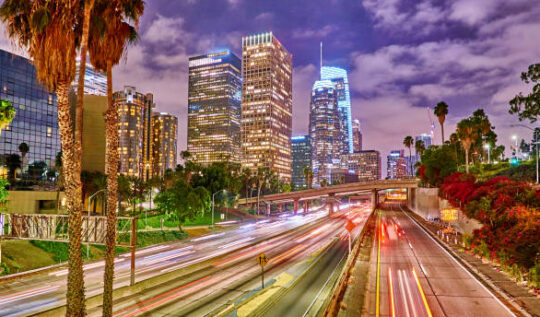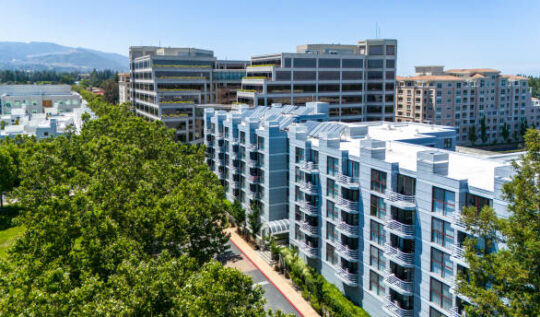Step-by-Step Guide to Applying for AB 2097 Parking Reduction in LA
Developers, architects, and property owners in Los Angeles often face strict parking requirements for new projects. These rules can increase construction costs and take up valuable space that could be used for housing or commercial areas.
Table of Contents
ToggleAB 2097 Parking Reduction in LA is a California law designed to ease these requirements for projects near public transit. It allows eligible developments to reduce or even eliminate the number of required parking spaces.
This step-by-step guide explains how to confirm eligibility, prepare your plans, and navigate the city approval process.
Following these steps carefully can save time, reduce costs, and help create more transit-friendly neighborhoods in Los Angeles.
AB 2097 Parking Reduction in LA – Step-by-Step Flow
Check zoning, measure distance to transit, and watch for location exceptions.
Prepare site plan, proof of transit distance, project description, and housing commitments.
Integrate parking reduction into plans, ensure code compliance, and review with professionals.
Submit online or in person with all forms, plans, and fees.
Work with Public Works, LADOT, and Building & Safety for review and compliance.
Address city comments, provide updated plans, and communicate with planners.
Obtain final approval, complete post-approval checks, and keep records for future use.
Understanding AB 2097 Parking Reduction
AB 2097 is a California law that allows certain projects near public transit to skip traditional parking requirements.
In Los Angeles, this can be a game-changer for developers, architects, and property owners. It helps cut construction costs, free up land for more housing or business space, and support a shift toward public transportation.

Why the Law Exists
Parking can be expensive to build and maintain. Large parking areas can also take away space that could be used for housing, retail, or community spaces. AB 2097 aims to reduce these costs and make it easier to create vibrant, transit-friendly neighborhoods.
Who It Applies To
The law covers a wide range of projects, including:
Residential buildings
Commercial properties
Mixed-use developments
If the site is close enough to a qualifying transit stop, the developer may not need to provide any parking spaces.
Defining “Proximity to Public Transit”
Under AB 2097, “near transit” usually means the project is within half a mile of:
A major bus hub
A rail station
Another large public transit center
The exact definition comes from state law, but Los Angeles uses its own planning maps to verify the distance.
Step 1 – Confirm Eligibility for AB 2097 Parking Reduction
The first step is to confirm that your property and project type meet the requirements. Doing this early saves time, prevents delays, and avoids costly redesigns later.
Check Zoning and Transit Maps
Use Los Angeles City Planning’s online zoning and transit maps to see:
Your property’s zoning classification
How far it is from the nearest major transit stop
You can also check with Google Maps or the city’s GIS mapping tools.
Measure Distance to a Major Transit Stop
AB 2097 generally requires that the site be within 0.5 miles of a major transit hub. Make sure your measurement follows the shortest walking route, not just a straight line on a map.
Watch for Location-Based Exceptions
Some properties may still be ineligible, even if they are close to transit. Examples include:
Coastal zones
High wildfire hazard areas
Historic preservation districts
If your site falls into one of these areas, you may still need to meet parking requirements.
Step 2 – Gather Required Documentation
Before you apply, you need a complete package of documents. A well-prepared submission speeds up the review process and reduces the chance of getting requests for more information.
Create a Detailed Site Plan
Your site plan should clearly show:
Property boundaries
Building footprint
Any proposed parking spaces (if applicable)
Driveway or access points
Make sure the plan is to scale and easy for reviewers to read.
Provide Proof of Distance to Transit
You must show that your site is within the required distance from a major transit stop. You can use:
GIS maps from the City of Los Angeles
Google Maps with marked walking routes
Official transit agency maps
Highlight the path from your site to the transit stop so it’s easy to verify.
Include a Project Description
Summarize the main details of your project. This should include:
Number of residential units or commercial spaces
Total floor area
Intended use of the property
Any affordable housing components, if offered
Add Any Required Housing Commitments
If your project includes affordable housing, provide proof of those commitments. This may be part of another city program, but including it here shows compliance with multiple policies at once.
Step 3 – Prepare Your Project Plans
Your plans should integrate the parking reduction request from the start. This ensures the design and documentation match what you are asking the city to approve.

Reflect Parking Changes in Architectural Drawings
Mark the number of proposed parking spaces directly on the plans. Also note the number that would be required under normal zoning, so reviewers can see the reduction.
Keep All Other Requirements in Mind
Even if you get a parking reduction, you still need to meet:
Building code requirements
Accessibility standards
Fire safety regulations
Parking relief does not exempt you from these rules.
Work With a Design Professional
An architect or planning consultant can make sure your plans meet both design goals and compliance needs. They can also help address any potential conflicts before you submit the application.
Step 4 – Submit Your Application to LA City Planning
Once your plans and documents are ready, it’s time to file your application. Los Angeles City Planning accepts submissions both online and in person.
File Through the City’s Online Portal
Most applicants use the Los Angeles Planning Department’s online filing system. This allows you to upload documents, pay fees, and track your case without visiting City Hall.
Prepare a Complete Application Packet
Include:
The application form
All required plans and drawings
Proof of distance to transit
Project description and housing commitments (if applicable)
A complete packet prevents delays and avoids additional document requests.
Pay the Applicable Fees
Filing fees vary based on the type and size of your project. You can pay online or in person at the planning counter.
Step 5 – Coordinate with Other City Departments
AB 2097 parking reduction requests often involve more than just City Planning. Other departments may need to review your plans before final approval.
Public Works
Check that your project’s street access and loading zones meet city standards. Public Works will also look at curb cuts and sidewalks to ensure they are safe and functional.
Los Angeles Department of Transportation (LADOT)
LADOT reviews how your project might affect traffic and curb space. Even with reduced parking, your building must allow safe vehicle and pedestrian flow.
Building and Safety
The Department of Building and Safety makes sure your plans meet:
Structural safety codes
Accessibility requirements
Fire safety standards
This review is separate from City Planning and must be passed before construction permits are issued.
Step 6 – Respond to City Feedback
After you submit your application, the city may send review comments. These notes are common and not a sign your project is in trouble. They help ensure your plans meet all local and state requirements.
Review All Comments Carefully
City planners often point out missing details, unclear measurements, or required design changes. Read each comment closely and address them one by one.
Provide Clear and Organized Responses
When replying, attach updated plans or documents. Label changes clearly so reviewers can see that you have addressed their concerns.
Keep Open Communication
If you are unsure about a comment, ask your assigned case planner for clarification. Clear communication can save weeks of back-and-forth.
Step 7 – Secure Final Approval and Permit Issuance
Once you’ve met all requirements and addressed feedback, the city can approve your parking reduction request. After approval, you’ll move into the final permitting stage.
Understand the Approval Timeline
In Los Angeles, the time from approval to permit varies. Simple projects may move quickly, while larger developments take longer due to additional reviews.
Complete Post-Approval Checks
Before you receive your building permit, inspectors may verify:
Parking signage and striping (if any spaces remain)
Compliance with shared parking agreements
Access and fire safety clearances
Keep Records for Future Needs
Keep all approval letters, stamped plans, and agreements in a safe place. These documents are important for inspections, refinancing, or selling the property later.
Tips for a Smooth AB 2097 Parking Reduction Process
Applying for an AB 2097 parking reduction in LA can be straightforward if you plan ahead. These strategies can help you avoid delays and keep your project moving.

Work With a Permit Expeditor or Zoning Consultant
Professionals who know the city’s process can save you time. They understand how to prepare documents, respond to comments, and meet all deadlines.
Anticipate Neighbor Concerns
Nearby residents may worry about street parking or traffic changes. Prepare clear answers and data to show how your project will still work for the neighborhood.
Keep Your Documents Organized
Store all plans, approvals, and communication in one place. This makes it easy to respond to city requests and helps with future property transactions.
Conclusion and Next Steps
AB 2097 is a valuable tool for Los Angeles developers, architects, and property owners. It can cut costs, open more space for housing or business use, and support a more transit-friendly city. The key is following each step carefully — from confirming eligibility to securing final approval.
If you want to make the process faster and smoother, work with an experienced planning consultant who knows how to navigate Los Angeles’ permitting system. Their guidance can help you secure your parking reduction and move your project forward with confidence.
Navigating AB 2097 parking reduction in LA can be complex, but you don’t have to do it alone. Consulting with an experienced planning professional can help you confirm eligibility, prepare accurate documents, and secure city approval efficiently.
Call today at (818) 233-0750 to schedule your free consultation and make your project transit-ready.
AB 2097 Eligibility & Transit Proximity
Project Type
Residential, Commercial, and Mixed-Use Developments can apply.
Transit Distance
Must be within 0.5 miles of a major bus hub, rail station, or transit center.
Location Exceptions
Properties in coastal zones, wildfire hazard areas, or historic districts may have restrictions.
Zoning Compliance
The project must meet Los Angeles City zoning and state AB 2097 requirements.
FAQs Regarding AB 2097 Parking Reduction
What is AB 2097 Parking Reduction in LA?
AB 2097 Parking Reduction in LA is a California state law. It allows certain developments near public transit to reduce or completely waive their parking requirements. The goal is to encourage transit-oriented development, save construction costs, and free up land for additional housing or commercial space. This law applies to residential, commercial, and mixed-use projects that meet location and eligibility criteria.
Who qualifies for AB 2097 parking reductions?
Eligible projects are generally located within 0.5 miles of a major transit stop, such as a rail station or bus hub. In addition to location, the property must comply with Los Angeles zoning rules and other state requirements. Coastal zones, wildfire hazard areas, or historic districts may have additional restrictions that limit eligibility.
Does AB 2097 apply to commercial projects?
Yes. AB 2097 applies to commercial and mixed-use projects in addition to residential developments. For example, a retail building or office space near a transit hub can request a parking reduction, provided it meets proximity, zoning, and city planning requirements.
How close must my project be to transit to qualify?
Projects must usually be within half a mile of a qualifying transit stop. The city measures this distance along walkable routes rather than straight lines. This ensures that residents or customers can realistically access transit without needing a car, supporting the purpose of reduced parking requirements.
What documents are required to apply for AB 2097?
A complete application typically includes a detailed site plan showing property boundaries, building footprints, and proposed parking spaces. You also need proof of distance to transit (such as GIS maps or Google Maps), a project description with unit count or floor area, and documentation of any affordable housing commitments. Submitting all required documents at once helps speed up the approval process.
Can AB 2097 eliminate all parking requirements?
Yes, in many cases, eligible projects can receive a full parking reduction. For instance, a multi-unit residential project near a major bus hub may not be required to provide any off-street parking. However, the project must still comply with all building, fire, accessibility, and safety codes. AB 2097 reduces parking requirements but does not waive other regulations.
How do I submit my AB 2097 application?
Applications can be submitted online through the Los Angeles City Planning portal or in person at the city planning office. The submission should include the application form, project plans, proof of distance to transit, supporting documents, and the required filing fee. Ensuring that your packet is complete helps prevent delays or requests for additional information.
Which city departments review AB 2097 applications?
Multiple departments may review your project. City Planning evaluates zoning and eligibility and Public Works checks street access and curb safety. While LADOT reviews traffic impacts and parking management, and Building & Safety ensures structural, fire, and accessibility compliance. Coordinating with all departments ensures that your project meets legal and safety standards.
How long does it take to get approval?
Approval timelines vary based on project size and complexity. Small residential projects may take a few weeks. On the other hand, the larger mixed-use developments with multiple departments involved can take several months. Timely submission of complete documentation and quick responses to city feedback can shorten the approval process.
What if the city requests changes to my plans?
City planners may request additional details, design adjustments, or clarifications. It is important to respond quickly with updated documents and clearly label any changes. Maintaining open communication with your assigned case planner can prevent further delays. It keeps your project moving forward efficiently.
Can I include affordable housing in my AB 2097 project?
Yes. Including affordable housing components is allowed. It can help strengthen your project’s compliance with state and local policies. Clearly document the number of units and any affordability requirements in your application. This not only ensures transparency but can also support broader city housing goals.
Do I need a consultant to apply for AB 2097?
A consultant is not required but can be extremely helpful. Planning consultants or permit expeditors understand city procedures. They help confirm eligibility, prepare accurate documentation, and coordinate with multiple departments. Using a professional can save time, reduce mistakes, and increase the likelihood of a smooth approval process.
What is AB 2097 and how does it impact Los Angeles?
AB 2097 is a State law that limits local governments from imposing Minimum Parking Requirements near a major transit stop. In Los Angeles, this makes it easier for developers to propose housing without being burdened by excessive automobile parking requirements.
When did AB 2097 take effect?
AB 2097 became effective on January 1, 2023. Since then, many housing development projects in Los Angeles can request parking reduction if they are located near public transit facilities or within walking distance of a transit stop.
Why did the State adopt AB 2097?
The bill was passed to align with regional housing need goals and reduce greenhouse gas emissions. By lowering parking mandates, the California Legislature aimed to encourage transit-oriented development and make better use of scarce land.
How do parking requirements work under AB 2097?
Under AB 2097, local government bodies, including City Planning in Los Angeles, cannot require parking spaces for projects within half a mile of a major transit stop. Developers may still provide parking agreements or unbundled parking voluntarily.
What qualifies as a major transit stop?
A major transit stop is defined in Government Code as a rapid transit station, ferry terminal, or the intersection of two or more frequent bus lines. In Los Angeles, this includes Metro rail stations and high-capacity bus corridors.
Can a public agency override AB 2097?
No. While public agencies may review project impacts, AB 2097 is a State law that overrides local government rules on parking minimums. Cities cannot add stricter parking requirements than those allowed by statute.
Does AB 2097 apply to all types of development?
The law primarily affects housing development projects, residential projects, and some transient lodging uses. Large commercial real estate and industrial projects may still face tailored parking mandates depending on land use.
How does AB 2097 affect housing needs in Los Angeles?
By removing strict parking minimums, more land can be used for housing instead of parking spaces. This supports the city’s housing element goals and reduces barriers to meeting regional housing need allocations.
Does this law reduce housing costs?
Yes, in many cases. Eliminating structured parking spaces can cut costs by tens of thousands of dollars per unit. These savings can help lower housing costs for renters and buyers in Los Angeles.
How does AB 2097 connect to broader planning goals?
The reform supports the land use element, conservation element, and the regional transportation plan. By cutting automobile parking requirements, Los Angeles aligns with state efforts to combat climate change and advance sustainable development.
How does State law affect parking near housing projects?
State law limits how cities can enforce old parking minimums. For example, projects near transit often qualify for reduced or eliminated parking requirements. This shift supports housing development while easing costs for builders and residents.
Why is the regional housing need important for Los Angeles?
The regional housing need sets targets that cities must plan for. In Los Angeles, these numbers guide zoning, density, and land use. Meeting these goals is essential to address housing shortages and affordability.
What role does the Government Code play in local zoning?
The California Government Code outlines rules for housing and land use. Local governments must follow these standards when updating zoning laws. This ensures housing development projects align with statewide priorities and fair housing goals.
How do parking minimums influence housing costs?
Parking minimums increase the cost of new housing projects. Developers must set aside land and money for automobile parking requirement compliance. Removing or reducing these minimums lowers costs and encourages more affordable housing.
What is Assembly Bill 2097, and why does it matter?
Assembly Bill 2097 restricts cities from requiring parking near major transit stops. The law encourages transit-oriented development and reduces greenhouse gas emissions. It also helps builders provide more housing instead of extra parking spaces.





